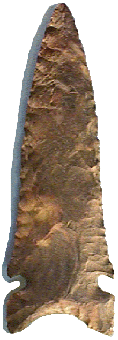

Point Type: GRAHAM
CAVE
Also See: Big Sandy, Godar,
Osceola, Otter Creek, Oxbow, Raddatz, Rowan , White River Serrated
Location: Midwestern United States
Associated Dates:
10000 - 7000 B.P. - Early Archaic to Mid Archaic
Morphology: Side-Notched
General Description: The Graham Cave type is a medium to large sized, long, slender or narrow, side-notched point with an incurvate blade point, pointed auricles and a deeply concave base which may or may not be ground. There are rare specimens which are fluted. The notches may be square to slightly rounded and are usually formed at a slightly upward angle from the base. The highly concave base makes the basal corners appear as if they are barbs. The point features fine flaking.
The shape of the blade differs as to the amount of resharpening by way of fine beveling. Unused specimens can have excurvate or straight edges similar to the Osceola and Hemphill points. Those that have been reworked a great deal will have incurvate/excurvate edges and very narrow blades that expand outward nearing the shoulders. The blades have cross-sections which are thick and bi-convex. Serrations can be present on reworked blades. Burlington chert was most commonly used in their manufacture.
There are three recognized variants to the type with their primary differentiation being the basal ear configuration and reworking attributes of the blade. Subtype A is a long version with small and precise side notches. The base is deeply concave and the basal ears have a barbed appearance. Subtype B has an excurvate blade and has a thin cross section relative to width. Subtype C has an excurvate blade and has rounded basal ears.
The Graham
Cave point can range in size from 50 mm to 152 mm in length and 20 mm to 34 mm
wide.
The point is typically found in Missouri, but can occur in parts of
western Illinois, southern Iowa, northern Arkansas, eastern Oklahoma, southern
Wisconsin and western Kentucky. The type is chronologically well documented
being found in early levels in the Graham Cave site, the Arnold Research Cave
site, the Rice Shelter site and the Rogers Shelter site in Missouri.
The
type was named by Wilfred D. Logan in 1952 and was formally described by Edward
G. Scully in 1951 for points recovered from three distinct levels within the
Graham Cave site, Montgomery County, Missouri.
About the Point Above: The point pictured at the top of this
page, is a classic example for the Graham Cave subtype A. It is 99 mm long, 31
mm wide at the basal ears, and is 9 mm thick at the barbs. The
width across the barbs is 30 mm and the concavity of the base is
7 mm. The point is made from a pinkish tanish flint that is
highly patinated and non-glossy. The flint has quartz inclusions
which are white and also has a few large pink inclusions. The
base and notches are ground. The auricles are thinned to 3.5 mm.
The base thickness at the concavity is 5 mm. The blade edges are
quite sharp and show some retouch. The blade was found near
Stanton, Lincoln County, Missouri. Catalog Number 239-285-L
References: Dragoo (c, d, e), Edler, Justice (1), Overstreet, Perino (3), Waldorf
© Copyright 1997 - 2008 LITHICS-Net WWW.LITHICSNET.COM
Use your Browser's BACK Button to return to the LITHICS-Net Index.